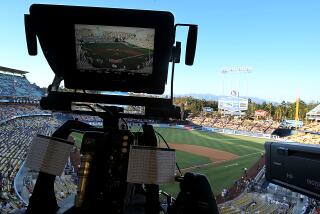Column: How to watch the Dodgers on TV
My life is a series of small pathetic failures broken up by unsustainable microbursts of clarity and achievement.
That’s why getting the Dodgers on TV the other night was so rockin’. My kid and I hugged as if we’d just climbed some digital Kilimanjaro. Which in a sense, is exactly what we’d done.
Emboldened by the buzz surrounding a new service, we changed a DNS code that masked our location. That allowed us to access an MLB.TV subscription, which till now had blocked Dodgers telecasts if you didn’t have a Time Warner Cable account.
If such hocus-pocus seems beyond your skill set, let me refer you back to Scene 1, Paragraph 1. In short, if I can do this, you can do this. I don’t see why everybody doesn’t do it, despite the $130 MLB season subscription.
Keep in mind, that’s roughly what you’d spend at the ballpark on parking, two beers and four anorexic hot dogs.
Even better news: The whole setup took less than 30 minutes.
The bad news? It requires a small investment, a bit of patience, and the right electronic chassis. My self-made Dodgers for Dummies kit also included an Apple TV device, which makes hooking up to subscriptions such as Netflix and MLB.TV about as easy as setting up a new coffee maker (previously, we’d used gaming consoles to access such things, but the Apple TV device is much simpler).
So, here I sit watching Clayton Kershaw and Adrian Gonzalez on TV after a yearlong forced abstinence. When that cute redhead crowed, “It’s time for Dodger baseball!” I’ll confess to getting chills — and an extra beverage from the beer fridge outside.
My work-around comes from Unlocator.com, an online service that guides even Luddites like me through an easy setup menu.
Essentially, Unlocator allows you to access Dodgers telecasts by telling you how to change what is known as your system’s DNS, which fools MLB.TV into thinking you’re outside the blackout zone. Sure, that sounds sinister, but Unlocator reps say you are doing nothing more than what millions of VPN users do every day when they sign on to their corporate network from home.
Can you get into trouble for it? Time Warner Cable declined to comment on the work-around. The Danes who run the Copenhagen-based Unlocator.com won’t guarantee that some local regulations might crop up. But for the most part, they say, only Iran and the United Arab Emirates have laws that prohibit this sort of digital zigzag, known in the Nerd World as “proxy service alternatives.”
Proxy, shmoxy, all I know is that the Dodgers and Giants are on my TV right now. And I’m far from alone.
“My brother has this setup,” says fan Matt Shupper, who has been using the service since the start of the year. “My dad has it, and five people from my son’s baseball team are using it.
Fine print deep in the MLB.com website warns of a $100 fine and service cutoffs to anyone trying to circumvent blackouts, though I have found no signs of any such crackdowns so far.
“I’ve had zero issues,” Shupper says.
Of course, overriding the Dodgers’ blackout goes back to the start of the standoff a year ago, when techie types started rerouting MLB feeds through foreign servers to disguise their locations. As you may know, a computer’s IP address is the digital lighthouse that lets a cable provider know where you are. TWC , which owns rights to Dodgers telecasts, has failed to get other major services to buy in so it has blacked out about 70% of local TV households from seeing the games on satellite or cable.
Savvy users had to download programs that spoofed the IP address, so that MLB.TV would think the user was in the Bahamas or Nova Scotia — pretty much anywhere outside TWC’s dragnet.
“Finding a good connection can take a while,” says one college student, who asked not be identified, and who still relies on a Canadian server. “But it’s much better than watching pixilated games on Moldovan gambling websites like my friends do.”
Locator.com is different in that it requires no software downloads, just the DNS alias and the instructions on how to change it.
A device known as Slingbox has become another popular way of getting around the blackouts. But it requires a TWC account someplace, often at a second residence in an area covered by TWC. In that case, Slingbox allows viewers to redirect — or sling — that cable signal over the Internet, where they can access the games on home TVs, phones and tablets.
“It’s extremely reliable, a very crisp signal. It works extremely well,” says one user, a JPL executive who asked not to be identified. He said the $120 device is about the size of a hardcover book and was an easy install.
But he’s a rocket scientist, after all. Me, I’m just a lost soul with a hole in his shoe on the boulevard of broken dreams.
And one of those dreams was to see Vin Scully in my den again, singing songs for a summer’s night.
Done.
Twitter: @erskinetimes
HOW TO GET STARTED
Unlocator.com: The service provides an alternate DNS number and instructions. Cost: $4.95 a month. Free seven-day trials also offered.
MLB.TV: Unlocator requires this subscription. Yearly subscriptions are $130. But if you don’t want to commit, monthly fees are $25.
Setup: Unlocator requires a wireless network or an Ethernet connection. It works with all sorts of gaming consoles, household routers, operating systems and media players such as Apple TV, Roku or Chromecast. In our case, Apple TV proved a 10-minute install, plus another 15 minutes to subscribe to MLB.TV via an iTunes account.
Slingbox: The streaming device is about $120, and install is simple. Also necessary: a TWC account that you can access over the Internet.
More to Read
Are you a true-blue fan?
Get our Dodgers Dugout newsletter for insights, news and much more.
You may occasionally receive promotional content from the Los Angeles Times.











